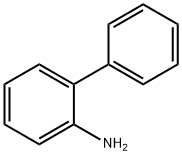A0632212
2-Aminobiphenyl , 98% , 90-41-5
Synonym(s):
2-Aminodiphenyl, 2-Phenylaniline;2-Biphenylylamine;2-Phenylaniline
CAS NO.:90-41-5
Empirical Formula: C12H11N
Molecular Weight: 169.22
MDL number: MFCD00007701
EINECS: 201-990-9
Update time: 2022-07-08
PRODUCT Properties
| Melting point: | 47-50 °C(lit.) |
| Boiling point: | 299 °C(lit.) |
| Density | 1.44 |
| vapor density | 5.9 (vs air) |
| vapor pressure | 2 mm Hg ( 140 °C) |
| refractive index | 1.613-1.615 |
| Flash point: | >230 °F |
| storage temp. | Store below +30°C. |
| solubility | Chloroform (Slightly), Ethyl Acetate (Slightly), Methanol (Slightly) |
| pka | 3.82(at 22℃) |
| form | Crystals or Crystalline Powder |
| color | Purple to brown |
| Water Solubility | <0.01 g/100 mL at 21 ºC |
| BRN | 471874 |
| Stability: | Stable. Incompatible with strong oxidizing agents. |
| InChIKey | TWBPWBPGNQWFSJ-UHFFFAOYSA-N |
| LogP | 2.84 |
| CAS DataBase Reference | 90-41-5(CAS DataBase Reference) |
| NIST Chemistry Reference | [1,1'-Biphenyl]-2-amine(90-41-5) |
| EPA Substance Registry System | 2-Biphenylamine (90-41-5) |
Description and Uses
2-Aminobiphenyl (2-APB) is an organic compound with the formula C6H5C6H4NH2. It is an amine derivative of biphenyl. It is a colorless solid, although aged samples can appear colored even black. Palladacycles obtained from 2-aminobiphenyl are popular catalysts for cross-coupling.
2-Aminobiphenyl has a mutagenic potency. It is a substrate for UGTs (UDP-glucuronosyltransferases), including UGT1A4, UGT2B13 and UGT2B16.
Safety
| Symbol(GHS) |   GHS07,GHS08 |
| Signal word | Warning |
| Hazard statements | H302-H351-H412 |
| Precautionary statements | P201-P202-P264-P273-P301+P312-P308+P313 |
| Hazard Codes | Xn |
| Risk Statements | 22-40-52/53-21/22/36/37/38/40-20 |
| Safety Statements | 36/37-61 |
| WGK Germany | 3 |
| RTECS | DV5530000 |
| Autoignition Temperature | 842 °F |
| TSCA | Yes |
| HS Code | 29214980 |
| Hazardous Substances Data | 90-41-5(Hazardous Substances Data) |
| Toxicity | LD50 orally in Rabbit: 2340 mg/kg |


